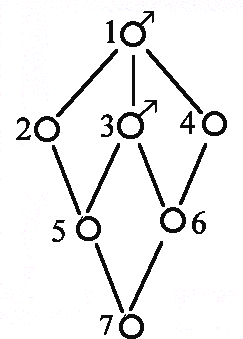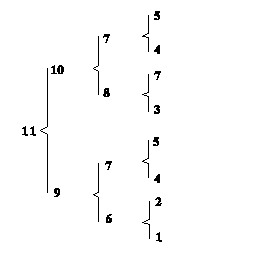animal sire dam --------------- 1 0 0 2 1 0 3 1 0 4 1 0 5 2 3 6 4 3 7 5 6

For larger sets of data use notepad or any other editor. Move the data to the
input area (left field) by means of the clip board using ctrl-ins (copy) and shift-ins
(insert).
The oldest animals should appear first, any numbers can be applied.
The Invert botton can only be run after an inbreeding run, or you put a matrix to be inverted in the output area!
Example:
Example of calculating inbreeding where the columns in the matrix shown below
are animal, sire
and dam, where the oldest animals should appear first. The pedigree are
converted in a matrix as done below (0 means unknown parent):
animal sire dam --------------- 1 0 0 2 1 0 3 1 0 4 1 0 5 2 3 6 4 3 7 5 6 |

|
Take these data including in the clip board and transfer them to left window
and there after press the 'Inbreeding' button and the inbreeding and relationship matrix should appear
in the right window.
There after use in the input window:
and press the 'Inbreeding' button
The relationship matrix will appear in the result window and will look as shown below.
Animal F (inbreeding)
1.000 0.000
2.000 0.000
3.000 0.000
4.000 0.000
5.000 0.125
6.000 0.125
7.000 0.218
Relationship matrix 1+F (inbreeding) in the diagonal
1.000 0.500 0.500 0.500 0.500 0.500 0.500
0.500 1.000 0.250 0.250 0.625 0.250 0.437
0.500 0.250 1.000 0.250 0.625 0.625 0.625
0.500 0.250 0.250 1.000 0.250 0.625 0.437
0.500 0.625 0.625 0.250 1.125 0.437 0.781
0.500 0.250 0.625 0.625 0.437 1.125 0.781
0.500 0.437 0.625 0.437 0.781 0.781 1.218
The inbreeding for each animal is given by its diagonal element minus
one, i.e. the last three animals are inbred with an inbreeding coefficient
of 0.125, 0.125 and 0.218 respectively.

For your own data put them in the matrix 'Animal sire dam' and repeat the process:
| ...... |

|
Animal Sire Dam , where 0 means unknown
-------------------
1 0 0
2 0 0
3 0 0
4 0 0
5 0 0
6 2 1
7 5 4
8 7 3
9 7 6
10 7 8
11 10 9
|
Calculate the inbreeding coefficient for the individuals No 10 and 11, and calculate the additive relationship coefficient between individual 11 and all others in the pedigree. The data set to be used for the calculations is given above.
What would be the inbreeding coefficient after 5 generation of full sib mating?
Back to the other programs or back to inbreeding theory. back to inbreeding theory (danish).